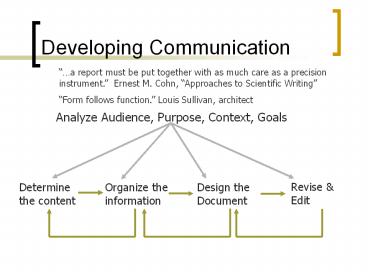Developing Communication PowerPoint PPT Presentation
1 / 11
Title: Developing Communication
1
Developing Communication
a report must be put together with as much care
as a precision instrument. Ernest M. Cohn,
Approaches to Scientific Writing Form follows
function. Louis Sullivan, architect
Analyze Audience, Purpose, Context, Goals
2
Successful Writing Is Useful
- It achieves your goals
- It achieves your audiences goals . . .
- for information
- for action
- for ease of use
- It adapts content, organization, language, style,
and design to audience needs
3
We Write What We Know
- In conducting the research for this project, I
first went to the library and searched the
catalogue for material on biosensors. I found
several books listed in the catalogue, but only
two of those were helpful. I then talked to the
reference librarian about where else to look. She
pointed me to the relevant databases and showed
me how to search on-line. My initial search
yielded 10,624 sources, so I narrowed my topic to
biosensors for detecting glucose levels in
diabetics, and have found 14 current articles
that seem helpful. I still have about 30
abstracts to review to complete this portion of
the literature search.
4
Instead of What Readers Need
- I have completed 75 of my research.
- Based on the information found to date, I have
narrowed the topic to biosensors for detecting
glucose in Type I diabetics. Thus far, my
research has yielded - 2 texts covering the history and current use of
glucose biosensors - 7 articles dealing with potential new materials
for these sensors - 4 articles on the limitations of current sensors
- 3 articles on pilot studies of alternative
sensing mechanisms - Work Remaining By April 8, I will have reviewed
and evaluated the remaining 30 articles found in
my preliminary search.
5
Analyze Your Audience Before You Write
- Key Factors
- Purpose what do they want to do?
- Learn
- Act
- Characteristics who are they?
- Responsibilities, Concerns, Motivations
- Contexts what circumstances influence them?
- Budget, Resources, Schedules, Relationships
- Key Decisions
- Content
- Organization
- Language/Tone
- Design
6
Common Communications Tasks in Engineering Design
- Proposing projects
- Sell services and seek project approval
- Seek input from all parties to develop a workable
plan - Provide contract between engineers and clients
regarding project deliverables, timelines, and
costs
7
Common Communications Tasks in Engineering Design
- Documenting work
- Provide a legal record of all steps
- Insure that everyone on the project team is on
the same page - Record design ideas, alternatives, decision
rationales, and related information to justify
actions - Record all necessary data and methodologies
8
Common Communications Tasks in Engineering Design
- Providing periodic updates
- Maintain open communication between parties
- Enable decision-making on the part of clients
(e.g. payment in phases) - Enable decision-making on the part of team
members - Enable team members to make decisions (design
ideas, next steps) - Enable managers to make decisions (personnel,
time, money)
9
Common Communications Tasks in Engineering Design
- Summarizing final results
- Make persuasive recommendations
- Summarize final designs for others to act (build,
buy, implement) - Provide a written record for legal accounting
- Contribute to ongoing knowledge (research)
10
What makes communication successful?
- Its not about you!
- Content addresses the needs, interests, and key
concerns of the audience. - Why is this information here?
- Organization gives the audience what they need in
the order they need it. - Why is this information here?
11
What makes communication successful?
- Design makes the information easy for the
audience to access. - Where is this information?
- Style makes the information easy for the audience
to read or absorb. - What in the world does this mean?

